Opportunities often arise when things look bleak. This phenomenon is recognized in Chinese language, where the character for crisis also means opportunity. Ironically, it was the panic in the Shanghai February 27, 2007 . It looked like a crisis thanks to the sharp downfall and the percentage lost that day and the following days. When the dust settled, however, opportunities were abundant, especially the one we spotted on March 13, 2007. Read on as we cover the successful trade we made as a result of this event and learn how you can find the similar opportunities.
The Setup
A rising wedge is a reversal pattern frequently seen in bear markets. This pattern shows up in charts when the price moves upward with pivot highs and lows converging toward a single point known as the apex. Using two trendlines - one for drawing across two or more pivot highs and a trendline connecting two or more pivot lows - the trendlines will show convergence toward the upper right part of the chart (Figure 1). This pattern has a familiar look to a bear flag (Figure 2). Figure 1 shows a rising wedge on a 60-minute chart, while a bear chart pattern is evident in the daily chart.
The Setup
A rising wedge is a reversal pattern frequently seen in bear markets. This pattern shows up in charts when the price moves upward with pivot highs and lows converging toward a single point known as the apex. Using two trendlines - one for drawing across two or more pivot highs and a trendline connecting two or more pivot lows - the trendlines will show convergence toward the upper right part of the chart (Figure 1). This pattern has a familiar look to a bear flag (Figure 2). Figure 1 shows a rising wedge on a 60-minute chart, while a bear chart pattern is evident in the daily chart.
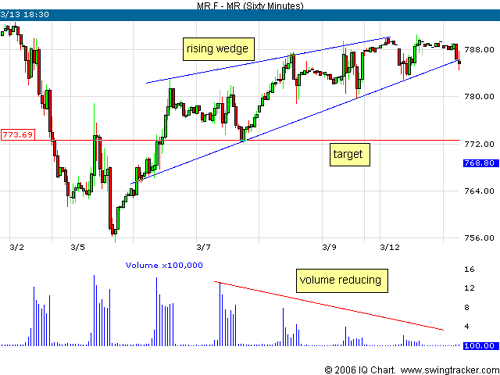 |
| Figure 1 |
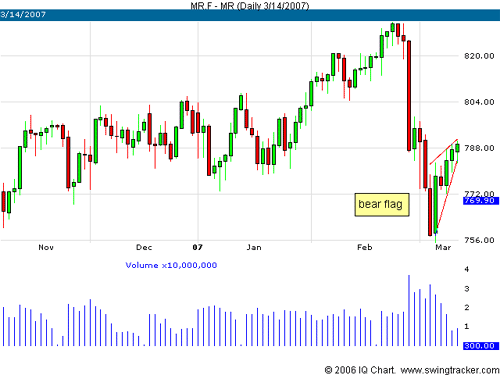 |
| Figure 2 |
The Pattern
In the days following the big drop that began on February 27, 2007, which was caused by the Shanghai stock market panic, the market continued to move down until it found the bottom on March 5, 2007. From that day onward, a general market recovery began, which continued for the next several days. On the e-mini Russell index, futures stood out in a pattern that many technical analysts would immediately recognize as a bear flag or a rising wedge (see Figure 1 and Figure 2).
During the formation, there are a few indicators that can be used to determine whether the pattern is a real pattern or a disguise. This formation typically moves toward to the right, and the volume should be decreasing, showing a divergence between price and volume. The second indication is to look for how far the retrace has advanced from the beginning of the downtrend. If the move has advanced well above the 50% Fibonacci level, this pattern might not be a valid pattern. If it's still under that level, the pattern is still valid. (For related reading, see Retracement Or Reversal: Know The Difference and Advanced Fibonacci Applications.)
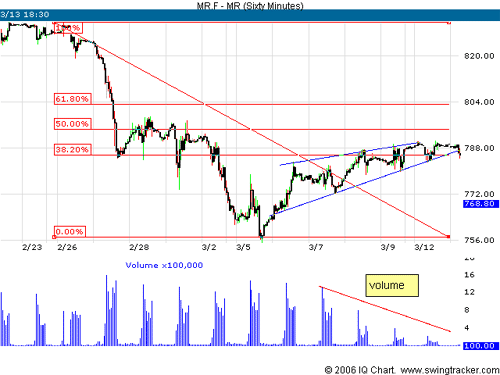 |
| Figure 3 |
The Breakdown
One thing experienced traders love about this pattern is that once the breakdown happens, the target is reached very quickly. Unlike other patterns, where a confirmation must be shown before a trade is taken, wedges often do not need confirmations; they normally break and drop fast to their targets. Targets are usually located at the beginning of the upper trendline, or the first pivot high where the trendline is connected. In this example, the target was set at 773.69.
|
Figure 4 shows the short entry was made when the price broke the lower trendline at 786.0, on the close of the bar that broke the trendline. It only took six hours to reach the target, compared to the several days that it took for the pattern to form before the breakdown.
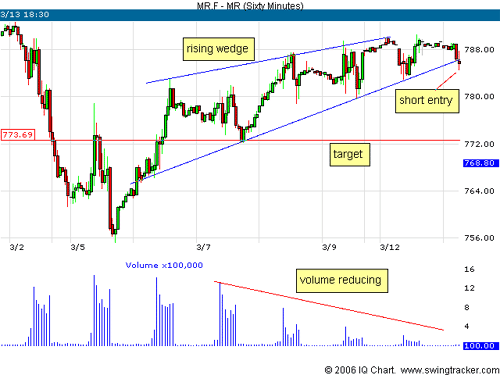 |
| Figure 4 |
In this case, correctly identifying a rising wedge put probability on our side and, luckily for us, the trade reached the target, shown in Figure 5, below.
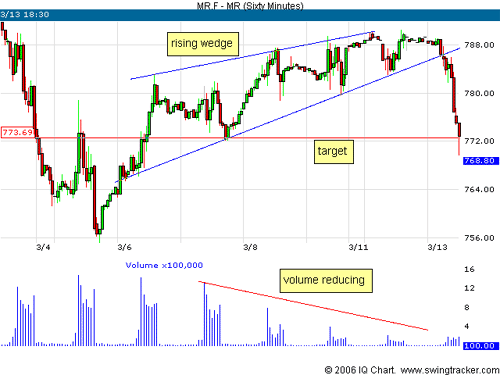 |
| Figure 5 |
The Outcome
Figure 6 shows the final result after the target is reached. Although the index continued to move lower, we exited the position and started looking for other rising wedge patterns.
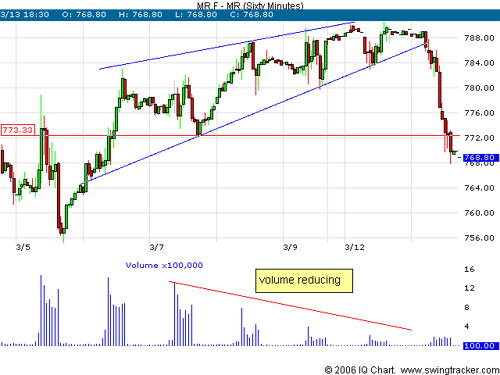 |
| Figure 6 |
Conclusion
Rising wedges have a very low risk/high reward ratio and, as a result, they are favorites among professional traders. But there are many false patterns, or patterns in disguise, that may come off as rising wedges. The only way to differentiate a true rising wedge from a false one is by finding price/volume divergence and to make sure the failure is still under the 50% Fibonacci retrace. As this example shows, when the breakdown does happen, the target is generally hit very quickly.
To keep reading about wedges, see Analyzing Chart Patterns: The Wedge.
By Larry Swing
Larry Swing is the President of the popular day and swing trading site, www.mrswing.com. MrSwing.com is a place where you can find free daily articles and videos covering education, market analysis and picks from Larry, his professional team and other well known traders in the industry. In addition to this, you'll also find an active forum where you can interact with and learn from experienced traders.
No comments:
Post a Comment